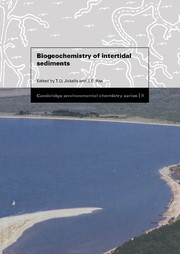Book contents
- Frontmatter
- Contents
- List of contributors
- Preface
- 1 Biogeochemistry of intertidal sediments
- 2 Trace metals in deposited intertidal sediments
- 3 Modelling adsorption and desorption processes in estuaries
- 4 A critical appraisal of the methodology used in studies of material flux between saltmarshes and coastal waters
- 5 Nutrient recycling in intertidal sediments
- 6 An overview of carbon and sulphur cycling in marine sediments
- 7 Microbial activity and diagenesis in saltmarsh sediments, North Norfolk, England
- 8 The behaviour of radionuclides in the coastal and estuarine environments of the Irish Sea
- 9 The sorption of hydrophobic pyrethroid insecticides to estuarine particles: a compilation of recent research
- Index
7 - Microbial activity and diagenesis in saltmarsh sediments, North Norfolk, England
Published online by Cambridge University Press: 23 September 2009
- Frontmatter
- Contents
- List of contributors
- Preface
- 1 Biogeochemistry of intertidal sediments
- 2 Trace metals in deposited intertidal sediments
- 3 Modelling adsorption and desorption processes in estuaries
- 4 A critical appraisal of the methodology used in studies of material flux between saltmarshes and coastal waters
- 5 Nutrient recycling in intertidal sediments
- 6 An overview of carbon and sulphur cycling in marine sediments
- 7 Microbial activity and diagenesis in saltmarsh sediments, North Norfolk, England
- 8 The behaviour of radionuclides in the coastal and estuarine environments of the Irish Sea
- 9 The sorption of hydrophobic pyrethroid insecticides to estuarine particles: a compilation of recent research
- Index
Summary
Introduction
The relationship between microbial processes, diagenetic reactions and mineralisation within intertidal sediments, including the development of diagenetic carbonate concretions, tubules and localised cemented layers, has attracted major interest in recent years. Such phenomena are relatively common in intertidal sediments around the British Isles and on other European coasts (see e.g. Pye, 1981; Andrews, 1988; Al-Agha et al., 1995; Duck, 1995). The processes associated with their formation are important in relation to the cycling of carbon, sulphur and iron, as well as the fate of industrial and other pollutants. Early diagenesis within saltmarshes in particular is of importance because of the high biological productivity which is characteristic of such environments, and their position at the interface between marine and terrestrial systems (see Vernberg, 1993, for a recent review of saltmarsh processes).
The role of microbial activity in early diagenesis has been recognised for some time, and a variety of approaches has been used to investigate these processes, including, for example, studies of C–S–Fe interactions (Berner & Westrich, 1985), rates of sulphate reduction (Jorgensen, 1978; Jorgensen & Bak, 1991), nitrate reduction (Sorenson, 1987) and Fe/Mn reduction (Lovley, 1991). Recently, significant progress has been made in quantifying the rates of microbial reactions and the interactions between biotic and abiotic factors (e.g. Blackburn & Blackburn, 1993; Parkes et al., 1993a,b), partly as a result of the application of biochemical techniques which allow detailed specification of microbial biomass, community structure and nutritional status (e.g. White, 1993; Eglinton, Parkes & Zhao, 1993).
- Type
- Chapter
- Information
- Biogeochemistry of Intertidal Sediments , pp. 119 - 151Publisher: Cambridge University PressPrint publication year: 1997
- 4
- Cited by



